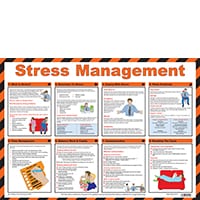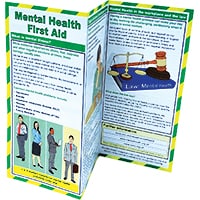
What is stress?
Stress is a negative response that people can have when they feel unable to cope with the pressures they face. Stress can manifest as a physical or emotional response and looks different in every person. The International Stress Management Association (ISMA) identifies 49 different signs of stress, categorised into psychological, emotional, physical and behavioural responses. This range of stress responses is what can make it so difficult to recognise and to deal with.
Equally important to note is that stress is entirely reliant on the perceptions of the stressed person; whether they feel that they have the resources to cope with the number and level of pressures they are facing. This is why comparison is not helpful when it comes to stress. One person, in a particular context, might be able to cope with more than they could in another context, or less than a different person could in the same context. This is also why our reactions and the level of stress that we feel in response to the same pressures can change day to day.
Why is stress significant?
Stress is not an illness – it is a physical and emotional state that we experience when we feel excessive amounts of pressure. However, when we feel stress, we put our bodies under stress. Our brains tell our bodies that we are in immediate danger and we go into “fight or flight" mode – useful when stress was caused by predators pursuing us, but not so much when it is caused by an overflowing inbox.
It can take our bodies 20-30 minutes to recover from stress, and this is fine if it is just a one-off. However, if your body is repeatedly sent into stress mode by negative thoughts and pressures, then it won’t have time to recover from each moment of stress.
Long-term stress can lower the immune system, making people more likely to catch infections, such as colds, and can even cause much more serious and long-term health conditions, from depression to diabetes.
How can stress impact workplaces?
If workers are suffering from prolonged or excessive stress, it goes without saying that this will impact their workplaces, particularly if their stress is work-related. The HSE Labour Force Survey found that 828,000 workers suffered from work-related stress, depression, or anxiety in 2019/20. This is equivalent to 2,449 workers per 100,000 and resulted in 17.9 million working days being lost.
There are four industries found to have had higher than average rates of work-related stress, depression, or anxiety between 2017 and 2020:
-
Nearly 3000 cases per 100,000 workers:
-
Electricity, gas, steam and air conditioning supply
-
Public administration and defence
-
-
Over 2000 cases per 100,000 workers:
-
Human health and social work activities
-
Education
-
Since 2014, there has been a gradual increase in the prevalence of work-related stress year-on-year, with a particularly sharp spike in 2019/20, which does not appear to have been driven by Covid-19. It is clear that, regardless of current unprecedented circumstances, work-related stress needs to be a firm focus for businesses moving forward.
What should workplaces do to reduce stress?
Stress is a major cause of sickness absence in the workplace (55% according to the Labour Force Survey) and costs over £5 billion a year in Great Britain. Main factors (cited by respondents to the Labour Force Survey) causing work-related stress, depression or anxiety were workload pressures, including tight deadlines, too much responsibility and a lack of managerial support.
In the Management Standards, the HSE have set out six key areas of work design that need to be properly managed to improve health, wellbeing, productivity and sickness absence. These cover the primary sources of stress at work and can be used by employers to complete a stress risk assessment and put in place strategies to reduce work-related stress:
- Demands – what is the workload like? What work patterns are there, e.g., number and duration of moments of high-pressure? What is the work environment like?
- Control – how much autonomy and independence is given to employees regarding the way they work?
- Support – how much support is provided to employees, in the form of sponsorship, resources, or line-management?
- Relationships – how well does the employer deal with unacceptable behaviour or conflict? Is positive working promoted?
- Role – how clear are employees about their role within the organisation?
- Change – how is organisational change - at all levels - managed and communicated?
Although this form of risk assessment considers the workplace as a whole, it should involve consultation of employees with thought given to how individual concerns can be responded to. As workplaces vary so widely, this form of risk assessment is one of the best ways to determine the factors causing stress in the workplace and identifying methods to reduce that stress.
It is essential that employees spend time and thought looking into work-related stress in their workplaces. There are a number of quick-fix suggestions for improving mental health and well-being that can be found online, however, without the foundations of a thorough and business-specific risk assessment, issues to do with work-related stress will remain.
Use this HSE step-by-step workbook to tackle work-related stress in your workplace.
Tips for helping cope with stress
If you are personally struggling with stress, or know someone who is, these strategies could help:
Communication
The first step is to communicate. Sometimes, just talking through your worries or task list can help you to see a way of managing them, or can give you a fresh perspective to help you cope. However, often in these moments, talking to someone who might be able to take a task off your hands – a line manager, family member or friend (depending on the task) – can give you that bit of breathing space to allow you to complete all of your work to the standard that you want. The American Institute of Stress has a whole article explaining how to use communication skills to manage stress.
Meditation
This can be difficult for many people, as it feels like
a whole new skill to learn. However, at its core, meditation is about sitting peacefully and managing your thoughts – exactly what is needed in a time of stress! There are plenty of free beginners guides that can be found online, such as this 10 minute meditation for stress, which provides a guided walk-through of meditative breathing exercises.
Exercise
Although exercise might feel like another task to add to your to-do list, it can help immensely in those moments of high stress. The fight or flight reaction to stress pumps adrenaline into our bodies and gets us ready for action. But if you’re just sat at a computer, dealing with digital or emotional stress, this physical energy has nowhere to go. Sometimes, in these moments, a brisk walk or run (it doesn’t have to be long – even 5 minutes) could help to relieve some of that nervous energy, helping you to focus on your task list when you get back. Of course, regular exercise can improve our mental health longer-term, making us better equipped to cope with high-pressure situations.
Products




Read our blog for more information on first aid, or contact us for further advice and information on our products.








